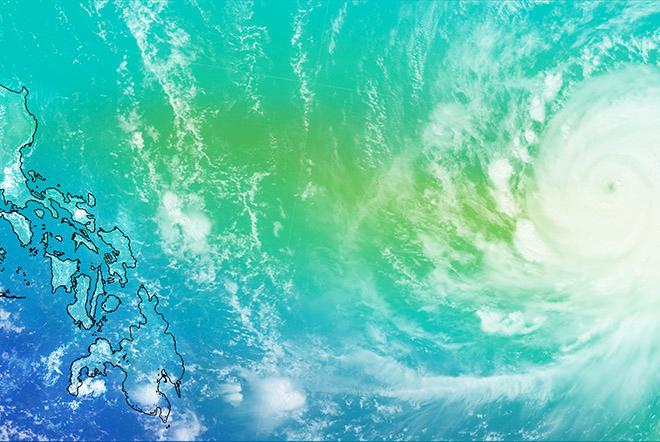More rainfall in warmer world intensify typhoons in western Pacific
by Mary Beckman on 6 Jan 2017

Super typhoon Haiyan bears down on the Philippines in 2013. NASA
http://www.nasa.gov
An analysis of the strongest tropical storms, known as super typhoons, in the western Pacific over the last half-century reveals that they are intensifying. Higher global temperatures have enhanced global rainfall, particularly over the tropical oceans. Rain that falls on the ocean reduces salinity and allows typhoons to grow stronger.
'This work has identified an extremely important region affected by this, the western tropical Pacific known as Typhoon Alley. These storms are really destructive over that region,' said oceanographer Karthik Balaguru of the Department of Energy's
Pacific Northwest National Laboratory, who published the work in a recent issue of Nature Communications.
The unique contribution of this work is that it identifies the need to study upper ocean salinity in addition to temperature in examining the intensity of typhoons. Typhoons — the same storms as their Atlantic cousins known as hurricanes — normally have a natural check on how intense they grow. The storms rely on heat from the ocean to build. Their strong winds whip up the ocean surface. This churns the ocean and brings deeper colder water to the surface, which cools off the surface and reduces the typhoon's power.
Previous studies suggested that as the planet warms, so does the surface of the ocean. As the temperature difference between surface ocean water and deeper water increases, ocean churning by typhoons cools the surface more strongly, which ultimately might decrease the intensity of tropical storms in the future.
But freshwater is less dense than saltwater. A warmer atmosphere brings more rainfall to the ocean than a cooler one. This freshwater collecting on top prevents the churning, keeping the surface warmer. Thus, a lack of ocean water mixing might mean a more intense storm.
Previously, studies that focused on global warming's effect on typhoons did not generally include the salinity factor, so Balaguru and colleagues at PNNL, National Oceanic and Atmospheric Administration and the Massachusetts Institute of Technology decided to incorporate it. This allowed them to look at the effect of freshwater on the ocean both in the past and the future.
They focused on the western Pacific Ocean, where almost a third of tropical storms form. First they looked at the salinity of the top layer of ocean. They saw that between 1958 and 2013, the ocean there did become less salty during typhoon season, and most of this decrease was in the top 50 meters of ocean. A quick overlay of the storms showed that the storm tracks fell along the areas of lower salinity.
To explore further, they looked at how the salinity changes affected the strength of super typhoons, storms that are as strong as category four or five hurricanes. To do so, they looked at the wakes of cold water the super typhoons left on the ocean as they passed, and how the wakes correlated with salinity. The results showed that in the regions of ocean that were less salty, the storms produced wakes that were not as cold.
The team then analyzed which of the two competing factors — the intensity bump from a decrease in salinity or the intensity snag from a larger ocean temperature gradient — played a bigger role in modulating the intensity of the super typhoons. They found that the influence of salinity was about 50 percent stronger than the ocean temperature effect on the intensity of super typhoons. Super typhoons are most affected by the changes because they rely strongly on ocean's heat as their fuel.
Plugging the relationships into climate model projections for the future, the team found that as greenhouse gases and temperature rise, the increase of rainfall over the oceans will ultimately lead to more intense storms. In addition, the team found this effect using almost 20 different climate models. This consistency gives the researchers confidence in the result.
'Already this effect is intensifying, and it gets worse in the future,' said Balaguru. 'The reason why this is so significant is that it's happening with the worst storms on the planet. Not only are they intense, but they are very, very big. It's happening in a really important region, to mostly small islands in the Pacific, such as the Philippines, Taiwan and other Oceania Islands. Besides, typhoons also impact many East Asian countries. And there is sea level rise in the background, a double whammy effect on top.'
This work was supported by the Department of Energy Office of Science and the National Oceanic and Atmospheric Administration.
For more information visit
website.
If you want to link to this article then please use this URL: www.sailworldcruising.com/150908